Kampung in the City
There is a perception that a visitor knows your “backyard” better than you do. We are so caught up with our daily schedules and chores that we never seem to have time to explore what’s around us, knowing that there is always “tomorrow”. I’ve often driven through Kampong Bharu as a short cut to avoid the traffic jam and the thought always goes through my mind that one day I must explore this Malay enclave in the heart of the city, filled with kampung houses and zinc-roofed dwellings, interspersed with coconut palms and street-side warungs.
A few old traditional Malay style houses stand out, a rare sight in our developed metropolitan city. Questions enter my head… what is the history of this enclave, why are there no other races living here, why is it called Kampong Bharu or “New Village”? The opportunity to find out the answers came when the MCG posted an event that I could not pass on – a Walking Tour of Kampong Bharu!


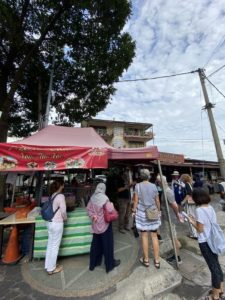
Our walk started at the Kampung Baru (new spelling) LRT station where we met Nadge Ariffin, our guide. Nadge explained that he grew up in Kampong Bharu – what better person to introduce us to the neighbourhood!
A brief history of Kampong Bharu
During the tin mining boom around the Gombak and Klang rivers in the 1900s, the British administrators with the consent of the Sultan of Selangor wanted to relocate the Malays who were living around the rivers to a new settlement (hence the name Kampong Bharu). Seven villages in total were amalgamated and one of the objectives was to encourage agriculture amongst the Malays in order to meet the increasing demand for food. Kampong Bharu was formalised in 1899 and was gazetted as the Malay Agricultural Settlement (MAS).
Kampung Houses
∙ Along our walk, Nadge pointed out several kampung houses built on timber columns using traditional techniques and others subsequently built with stone. The columns support the house, with a stairway leading to a front porch and front door. The purpose of this type of raised house was to prevent flood waters and wild animals entering the house. Interestingly, when building the columns, the wife of the houseowner would take a string, hold it on outstretched arms and the length of the string from fingertip to fingertip would be the distance between columns – hence the size of the house would ultimately depend on the length of the wife’s arms!
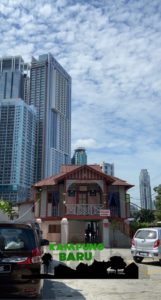
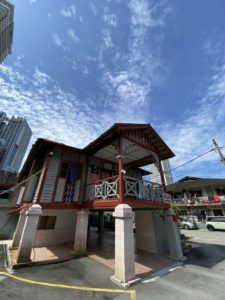

The sides of the house have large shutter windows for ventilation throughout the house.
∙ It was quite common to have two separate sections to the house, the front section, Rumah Ibu, being the main house with steps at the back leading down to the back annex, Rumah Dapur, which housed the kitchen. Should there be a fire in the kitchen, that section could be brought down and the fire contained to prevent it spreading to the main house. Rumah Ibu would be built with more superior materials.

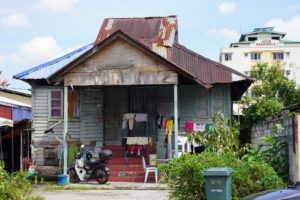
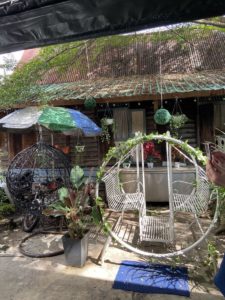
∙ The roofs were traditionally thatched, made of Nipah palms which is cooler, and the shape of the roof denoted the region from where the owner originated. We were able to diffentiate Melaka style houses with double sloped roofs and Perak style houses with a more elongated roof stretching front to back.
∙ The houses were originally built without nails but as time went by nails were used to repair the houses.
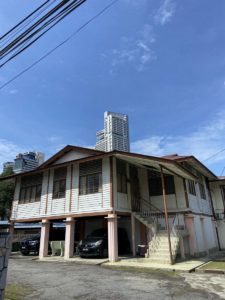
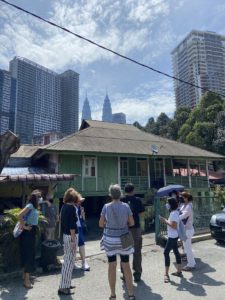

∙ Most of the houses are still owned and occupied by the descendants of the original owners. As the passage of time has resulted in each house invariably being owned by several members of a large family, it is now often very difficult to get all to agree to sell the property.
∙ Sadly those that are not owner occupied are in a sad state of disrepair.
Some notable houses that Nadge pointed out:
∙ 1st house – (cream with light blue trimmings). Melaka style built in 1920, looking homely and lived in.
∙ 2nd house – (white with rust coloured trimmings). Perak style house, which was damaged during the war and rebuilt in1949. It is very well kept showing Rumah Ibu and Rumah Dapur, stone columns, large windows and stairway leading to a front porch and doorway. It belonged to a famous teacher, the son of the original owner.
∙ 3rd house – (green with white trimmings). Perak style built in 1949 with verandah all round the house, looking rather dilapidated.
∙ 4th house – (pink house with brown trimmings). Melaka style, still occupied by the owner who has converted it into a homestay. This house shows the original beams joined together without nails.
∙ 5th house – (white house with brown trimmings and green steps). Built in 1953, owner occupied. They have maximised on the space under the house by building extra rooms.
∙ 6th house – (black house). Melaka style. This house was spacious enough inside to accommodate the Sultan of Selangor and his entourage during their visit in the 1980s.
At every photo worthy angle you take of the houses, you will see the contrast of the old house and the modernity of the skyscrapers behind as backdrop. Let’s hope Kampong Bharu stays as we see it today and development does not creep in.

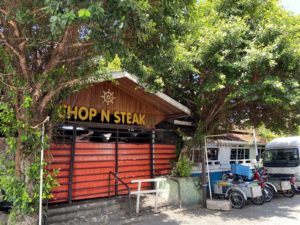
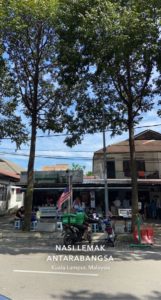
A taste of Malay food
Everywhere you turn there are warungs and stalls, eateries offering you tantalising options for breakfast, lunch, dinner and late-night supper for the night owls. A few notable ones worth mentioning and checking out:
∙ The famous Nasi Lemak Antarabangsa interestingly named because the MAS pilots and flight attendants used to stop by this stall to buy nasi lemak before their international flights, to stave off their cravings for spicy Malaysian food.
∙ The neighbouring Nasi Lemak Wanjo, cousins of Nasi Lemak Antarabangsa, also has good ratings.
∙ Next to the Masjid Jamek Kampung Baru, there is a stall known for their free distribution of a special porridge called buburlambuk to the public during Ramadan. They sell buburlambuk at other times as well as pisang goreng
(Malaysian banana fritters).
∙ Chop N Steak, a restaurant with maritime decor offers Malaysian style Western food (eg. chicken chops, steaks etc.) at affordable prices. Another highly rated place.
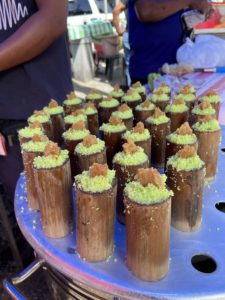
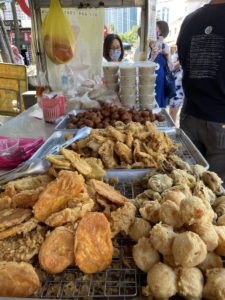
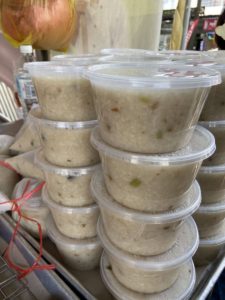
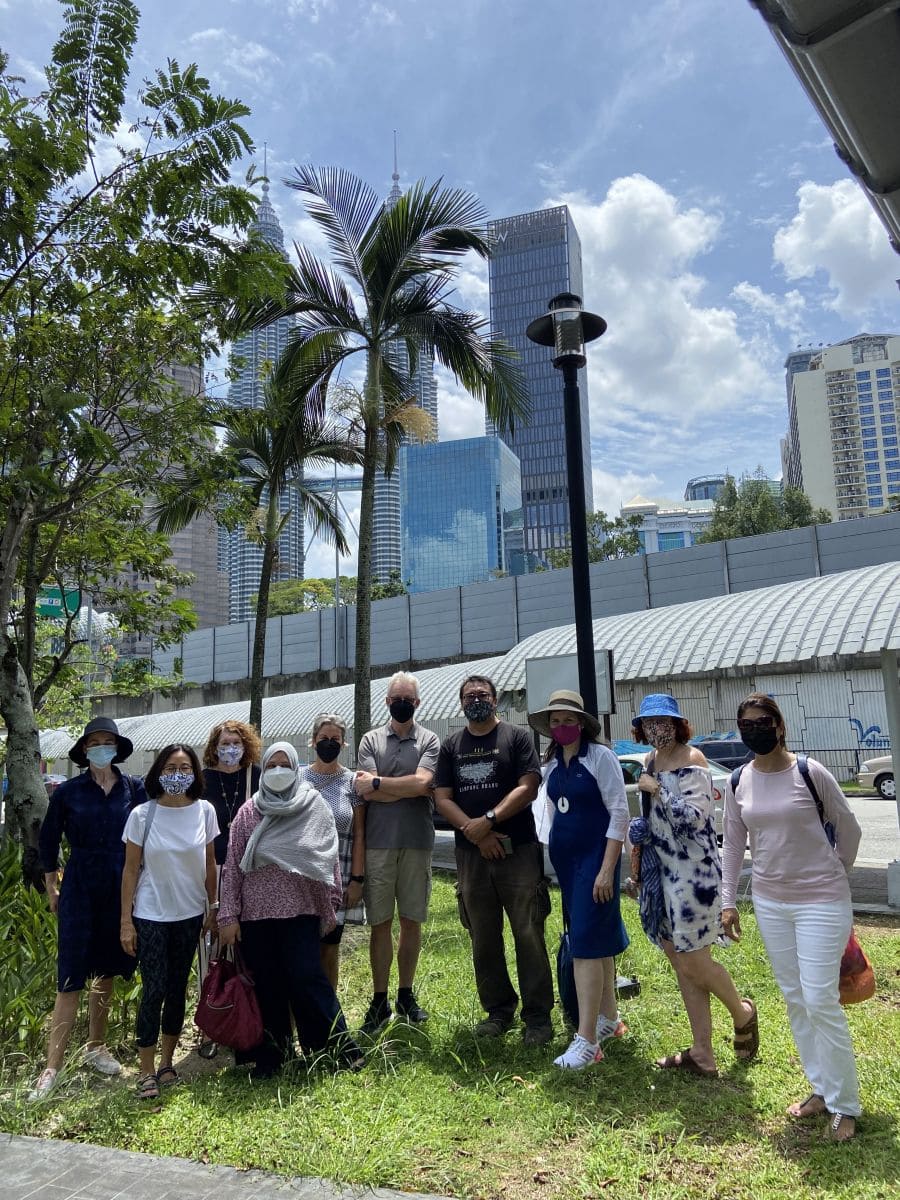
Our walk ended back at the LRT station with all of us feeling very hot and desperately needing a long cold drink! A big thank you to Nadge for an enjoyable and interesting tour, who piqued our interest enough to want to revisit Kampong Bharu again to discover the amazing variety of food or perhaps to walk the other “half” of Kampong Bharu, which after all does span 232 acres in its entirety.
As always, a big thank you to Michelle Pease, Marianne Khor and the team at MCG Events Planning for their tireless efforts in organising such fascinating events. I look forward to more walks to discover “my backyard”!
Doreen Tan
